Don’t let those huge blooms fool you! It is easy to grow hibiscus with dinner plate-sized flowers if you follow a few simple tips. Yours will be the envy of the neighborhood every summer if you treat them right!
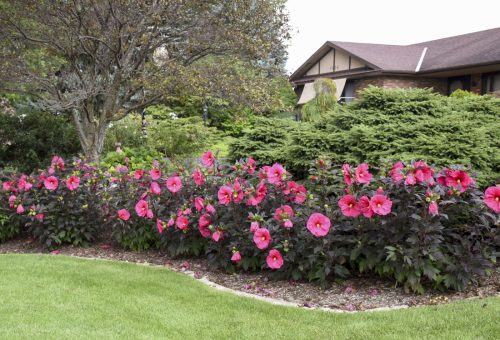
Hibiscus Summerific® ‘Evening Rose’
The tropical flair that perennial hibiscus exudes may fool you into thinking they wouldn’t be hardy in your area, but chances are good you can grow this amazing perennial where you live. Its hardiness ranges from zone 4 (-20°F to -30°F), which extends as far north as Minnesota, to zone 9 (20°F -30°F), which includes hot, humid climates like Florida and North Texas. It can be grown outdoors in your garden without bringing it in for winter in those zones.
They aren’t to be confused with tropical hibiscus which are grown as houseplants in all but the warmest climates, or with the shrub form Hibiscus syriacus, commonly called Rose of Sharon.
Perennial hibiscus needs three main things to thrive: sun, water and space. Each should be provided in abundance. Let’s take a closer look.
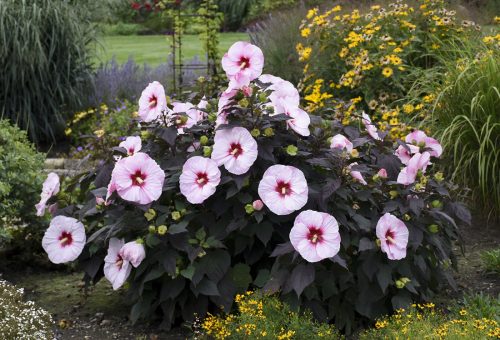
Hibiscus Summerific® ‘Perfect Storm’
SUN
Perennial hibiscus needs lots and lots of sunshine to grow well, develop its proper coloring, and bloom well. The best place to plant your new hibiscus is where the sun shines all day long. Full sun (6+ hours) is especially important for those grown as much for their dark purple foliage as their dinner plate-sized blooms. The purple coloring develops as a response to UV light from the sun, so plants grown in shade will have greener leaves.
Sun provides energy for hibiscus to form its flower buds. Even if you live in the South, you should grow hibiscus in full sun to maximize its flower power. If your only choice is to grow it in part sun, make sure it receives at least a few hours of warm afternoon sun.
Hibiscus Summerific® ‘Cranberry Crush’
WATER
Perennial hibiscus are very thirsty plants. In their native habitat, they can grow in shallow water and along streambanks. They also thrive in humidity. If you live in an arid climate, this perennial is not the best choice for your garden.
Be sure to plant your perennial hibiscus where the automatic sprinkling system will hit it on a regular basis. If you hand-water your garden, plant it near your hose to make it easy to give it a drink frequently. Try not to let the soil dry out much, especially if you have clay which can become very hard when it’s parched. Amending the soil with compost at planting time and mulching around the base will help to retain moisture.
You know your perennial hibiscus is not getting enough water if:
- The whole plant is drooping
- The flower buds are turning yellow and falling off before they open
- The leaves start to turn fall colors well before that season has arrived
Hibiscus ‘Summer in Paradise’
SPACE
Some people are surprised when perennial hibiscus dies all the way back down to the ground in the fall. They assume a plant of this size would be a woody shrub, but it actually is an herbaceous perennial. As such, the plant drops its leaves late in the fall and comes back from the roots the following spring.
Perennial hibiscus range in size from about 3 to 6 feet tall and usually grow wider than they are tall. They also mature very quickly. If you are starting with a small plant, don’t be fooled into thinking you can plant it someplace temporarily and then move it in a few years. Its large root system will make it difficult to transplant after just a year or two.
A better idea is to plant your new hibiscus somewhere it will have plenty of room to mature over the next few years. Fill in around it with colorful annuals for the time being as it grows. Each year, you will need fewer annuals to fill the surrounding space. By the end of year three, your perennial hibiscus will be nearly full grown.
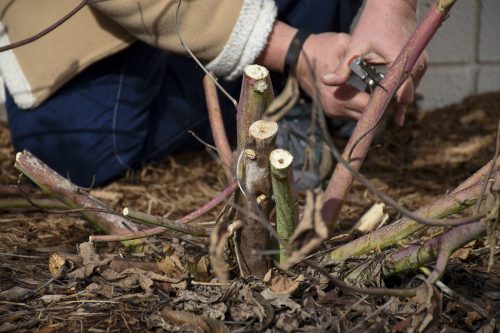
PRUNING
It is important to cut down all of the old, woody stalks of perennial hibiscus every year in the spring to make way for the new growth. You can see how the new growth emerges from the roots in this video. No new foliage will grow from last year’s stems—this perennial re-sprouts all new growth every year, just like any other herbaceous perennial.
If you look closely at this picture, you will notice that the center of a perennial hibiscus stem is hollow.
Rain and snow can get into those hollow cut stems and cause rot or freeze/thaw in the crown of the plant when the plant is not actively growing. It is for this reason that we recommend cutting the plant down in spring rather than in the fall.
Use a hand saw or a sharp pair of loppers or pruners to cut down the stalks to a height of about 6 to 8 inches. This will expose the crown of the plant to the sun and stimulate new growth.
No additional pruning should be needed or is recommended throughout the season. If your perennial hibiscus grows taller than you’d like it to, do not trim down the stems because doing so will sacrifice the flowers. Better to wait until next spring to transplant it someplace where its full size will be appreciated.
PESTS
Botanically speaking, perennial hibiscus is in the rose family, and Japanese beetles enjoy attending the family reunion each year just like they do with roses. If this pest is an issue in your area, the long-term solution is to treat for them when they are in the grub stage in your lawn. Milky spore is considered one of the best treatments, but it takes a couple of years to work well. In the meantime, knocking off the beetles into a bucket of soapy water is effective.
Watch also for hibiscus sawfly larvae which looks like a small green worm in its juvenile stage. Like Japanese beetles, they chew holes in the leaves, sometimes quite extensively. Systemic insecticides are effective on sawfly larvae.
A NOTE ABOUT YOUR NEW HIBISCUS FROM GARDEN CROSSINGS
Here are a couple of things you’ll want to know about the new hibiscus we ship to you:
- Like we mentioned above, purple-leaf hibiscus need exposure to the sun’s UV rays to develop their purple coloring. The plant you will receive was grown in our greenhouses which do not let UV rays in, so you can expect its foliage to be green when you receive your plant. Once you set it outside in the sun, the leaves will quickly regain their purple color.
- Any perennial you buy from a garden center, including hibiscus, may bloom off cycle the first year. Factors like when it was planted in the pot and how it was trimmed to fit in a shipping box can all affect blooming. Your new hibiscus might bloom this year, but it is more likely that it will flower the following year at its natural time in mid to late summer.

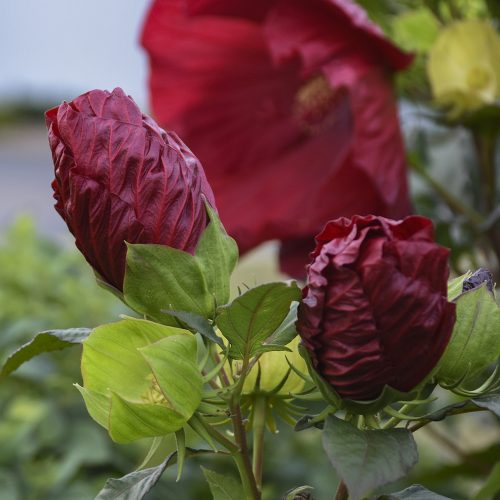
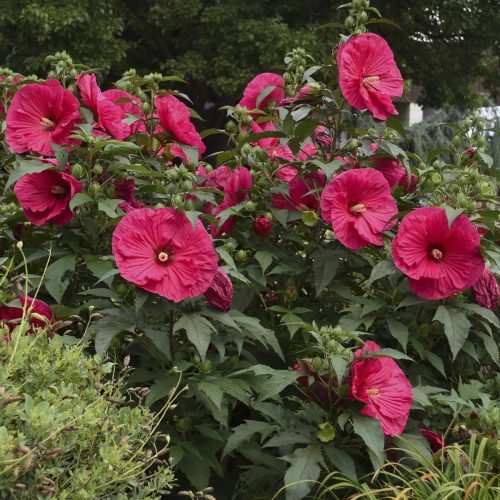
39 thoughts on “How to Grow Dinner Plate Hibiscus”
I have a Summerific root ball. They arrived with the stems cut back. I live in Zone 8. Can these be planted in the ground this time of year (November 2)?
Yes I would recommend getting it planted.
Hi, I wanted to buy a few for my king driveway flower bed, I’m not concerned about the height but am wondering if they are able to grow with a smaller width flower bed (about 1.5 ft)? Will they just stay smaller but still survive? The flower bed is enclosed by brick
The roots will grow in a 1.5′ space, but the plant will get bigger and hang in your driveway.
Long driveway*
Okay awesome thanks for your reply! Is it too late in the year if I ordered them and plant them now?
You should still have plenty of time if you plant now.
I have a hibiscus that is very leggy i have maybe 6 tall stalks with buds but a lot of stems just sticking out of the ground.. what can I do to make this more fuller
I recommend trimming all the sticks back to 4-6″ in the spring. This will help with the ‘dead’ looking stalks. Make sure your plant is in full sun and it may need fertilizer.
Thinking of getting cookies and cream hibiscus, this one will be my 7th one I have, as well as 6 rose of sharon.
Very informative ! Thank you!
I have a 4 year old that lives very happily in my front garden (west side of the house) but can be challenged because it is surrounded by Hosta’s, Indian Hawthorn, Lindheimer’s beeblossom (Evening Primrose) and day lilies. Problem solved by putting a low fence (24 in) about 12 to 15 inches from the crown and guiding the new growth to rest on top of the fence as it recovering in the spring. As a matter of ease, we cut back in the fall, as we are in Delaware near the coast, and see very little to no snow. Just planted a second one in back, surrounded by lawn.
Why are the buds on my dinner plate hibiscus turning into leaves instead of big beautiful flowers?
Hi Judy, The ‘buds’ that are turning into leaves are possibly the seed pods from a flower that has fallen off.
Are hibiscus plants deer-resistant?
Yes, they are. But like anything, if the deer are hungry enough they will eat them.
Hello! So much excellent advice here! I have the tall dinner plate hibiscus and have been cutting the canes back in the fall to about six inches. I will now wait until Spring. My question is, I now have about three or four years worth of these cane “stumps,” and there is less room for new canes to come up. Is there a point when those cane remnants can or should be removed? If so, what is the best way to do this? Thank-you!
There is no need to remove all the old canes if they are about 6″ tall. the plant will continue to keep putting up more stems.
If you want to, you can try splitting your hibiscus if it is old.
The stalks are so thick and they fall over – how can I keep them fairly upright? I’ve been trying to contain them with heavy string tied to a deck railing, but this year I may have more than 15 stalks since I had a dozen last year. Help!
Interesting. In my experience, they are a pretty sturdy plant. Maybe send us pictures once you start to see this happen. I can try to help you with a solution. Make sure they are in a full sun location.
Where can we purchase dinner plate hibiscus…looking to purchase more, can I ordered seed of the 12 inch zone 4
We have several varieties available in a quart. We do not sell seeds.
We use wire fencing to create a cage around the new growth when it’s about a foot tall. 2 18 inch pieces of fence on top of each other wired to the fence behind the plant. Really keeps it upright. Another trick we use are shepherd hooks to prop up the extra heavy branches. Bush is so full you can not see the cage or hooks. Hope this helps.
My Hibiscu’s trunks are braided together and formed into a tree. How do I prune it?
It sounds like you have a tropical hibiscus. I would recommend trimming 1/3 off the top of the canopy of your tree. This may remove the foliage and flowers, but it should flush back out for you.
For those new to Hibiscus, would you please show a video of how to cut them back after the first full bloom ? I see so many plants loaded down with seed, and no new growth , and blooms.
I cut off any spent blooms and seed pods every morning, so my plants put their energy into new growth and more blooms. Here in zone 8 , they bloom from the middle of May, until frost in the middle of November. Quite a job since I have 30+ very large plants, but so worth it.
See if this video answers your questions. https://www.youtube.com/watch?v=AZL_uyZX0tE&t=264s
This video is about hydrangeas. I also have question on hibiscus. It finished blooming ; do I deadhead the seed pods and if I do will it set up more flowers?
You can deadhead, but that will not create more blooms. This is a plant that has its bloom cycle and them is done.
I live in Calgary how well will Hibiscus do in my shelter garden
It depends on your hardiness zone. These are hardy down to zone 4 and up to zone 9.
I am going to be moving from Ohio to zone 10a. Can I bring my hibiscus with me?
I planted mine in a biggish pot last year. Will it survive in a pot? I don’t have the space in my garden so I thought I’d give it a try?? Thanks for any advice x
I would recommend a pot that is at least 18-24 inches across with plenty of soil volume. These do best when planted in the ground.
Excellent article. This plant is a super hero in my garden. I am challenged by neighboring black walnut trees and while this plant doesn’t thrive near it is a survivor and stills looks amazing. The ‘space’ section is especially helpful, one of mine has expanded it borders so the annuals are no longer needed. May I ask a favor please? I am interested in transplanting a couple of mine this fall. Can you please provide some guidance? I am finding this online but your expertise appears more thorough and this is simply the most stunning plant in my garden even outshining my Starglazer lilies.
Transplanting can be done in the spring or fall. I would recommend the fall after it is done flowering. Make sure to water it well before digging it up and then watering well once it is transplanted. Depending on where you live, the ground stays planty warm in the fal/ late fall for the roots to get reestablished.
I too have black walnuts in my neighbour’s garden. I try my best to pick up leaves, branches and walnuts. I love dinner plate hibiscus and am wondering if they are a good choice for my garden.
The information that I have found online says that they should be ok.
I am very interested in purchasing a Summerific Hibiscus. I am in zone 9B. Do you recommend the hibiscus for my area? And secondly what size of plants do you offer?
Thank you for asking. Yes, they should do fine for you in your zone 9 gardens. We carry both quart and gallon sizes depending on what’s available when.